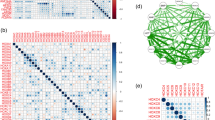Abstract
Breast cancer is the most frequent malignancy among females. In this study, we analyzed the expression pattern of a homeobox gene (HOXD10) in human invasive ductal breast cancer tissues and normal tissues. With the ACTB (β-actin) gene as a reference, HOXD10 was detected in 60 breast cancer tissues by using the quantitative real-time PCR (qPCR) method with the Relative Expression Software Tool (REST). We found that the HOXD10 expression level was significantly different between cancerous and normal tissues. Downregulation of the HOXD10 gene expression was examined in high-grade samples. Low-grade tissue showed no difference from the control group. HOXD10 expression was reduced in grade II breast carcinoma tissues. This data reveal that misexpression of the HOXD10 gene supports the development and involvement in breast cancer and may serve as a potential biomarker for the diagnosis of human ductal invasive breast carcinoma.



Similar content being viewed by others
References
Globocan 2012;http://globocan.iarc.fr
Murthy NS, Chaudhry K, Nadayil D, Agarwal UK, Saxena S. The changing trends of breast cancer, the Indian scenario. Indian Journal Of Cancer National Cancer Registry Programme ICMR, Division of Non-Communicable Diseases, Indian Council of Medical Research. Indian J Cancer. 2009;46:73–7.
Li CI, Anderson BO, Daling JR, Moe RE. Trends in incidence rates of invasive lobular and ductal breast carcinoma. JAMA. 2003;289:1421–4.
van't Veer LJ, Dai H, van de Vijver MJ, et al. Gene expression profiling predicts clinical outcome of breast cancer. Nature. 2002;415:530–6.
Sotiriou C, Pusztai L. Gene expression signatures in breast cancer. N Engl J Med. 2009;360:790–800.
Krumlauf R. Hox genes in vertebrate development. Cell. 1994;70:191–201.
Zakany J, Kmita M, Duboule D. A dual role for Hox genes in limb anterior-posterior asymmetry. Science. 2004;304:1669–72.
Redline RW, Williams AJ, Patterson P, Collins T. Human HOX4E, A gene strongly expressed in the adult male and female urogenital tracts. Genomics. 1992;13:425–30.
Abate-Shen C. Deregulated homeobox gene expression in cancer, cause or consequence? Nat Rev Cancer. 2002;2:777–85.
Samuel S, Naora H. Homeobox gene expression in cancer, insights from developmental regulation and deregulation. Eur J Cancer. 2005;41:2428–37.
Robson EJ, He SJ, Eccles MR. A panorama of PAX genes in cancer and development. Nat Rev Cancer. 2006;6:52–62.
Osborne J, Hu C, Hawley C, et al. Expression of HOXD10 gene in normal endometrium and endometrial adenocarcinoma. J Soc Gynecol Invest. 1998;5:277–80.
Makiyama K, Hamada J, Takada M. Aberrant expression of HOX genes in human invasive breast carcinoma. Oncol Rep. 2005;13:673–9.
Redline RW, Hudock P, MacFee M, Patterson P. Expression of AbdB-type homeobox genes in human tumors. Lab Invest. 1994;71:663–70.
Miller GJ, Miller HL. Adrie van Bokhoven Lambert JR, Priya, N, Werahera OS, Scott Lucia M, Steven K N et al. Aberrant HOXC expression accomplishes the malignant phenotype in human prostate. Cancer Res. 2003;63:5879–88.
Cantile M, Pettinato G, Procino A, Feliciello I, Cindolo L, Cillo C. In vivo expression of the whole HOX gene network in human breast cancer. Eur J Cancer. 2003;39:257–64.
Cantile M, Schiavo G, Terracciano L, Cillo C. The HOX gene network as a potential target for cancer therapy. Current Cancer Therapy Reviews. 2007;3:17–24.
Livak KJ, Schmittgen TD. Analysis of relative gene expression data using real-time quantitative PCR and the 2ΔΔCT method. Methods. 2001;25:402–8.
Sobin LH, and Witterkind C(eds.). TNM classification of malignant tumours. 6th edition. Wiley-Liss, New York: 2002; 131–141.
Olson J. Bathsheba’s breast: women, cancer, and history. Baltimore: John Hopkins Press; 2002.
Pfaffl MW, Horgan GW, Dempfle L. Relative expression software tool (REST(C)) for group-wise comparison and statistical analysis of relative expression results in real-time PCR. Nucl Acids Res. 2002;30:e36.
Derveaux S, Vandesompele J, Hellemans. How to do successful gene expression analysis using real-time PCR. J Appl Meteorol. 2010;50:227–30.
Goetz MP et al. A two-gene expression ratio of homeobox 13 and interleukin-17B receptor for prediction of recurrence and survival in women receiving adjuvant tamoxifen. Clin Cancer Res. 2006;12:2080–7.
Jansen MP et al. HOXB13-to-IL17BR expression ratio is related with tumor aggressiveness and response to tamoxifen of recurrent breast cancer: a retrospective study. J Clin Oncol. 2007;25:662–8.
Chou WC et al. Acute myeloid leukemia bearing t (7; 11) (p15; p15) is a cytogenetic entity with poor outcome and a distinct mutation profile: comparative analysis of 493 adult patients. Leukemia. 2009;23:1303–10.
Hedlund E, Karsten SL, Kudo L, Geschwind DH, Carpenter EM. Identification of a Hoxd10-regulated transcriptional network and combinatorial interactions with Hoxa10 during spinal cord development. J Neurosci Res. 2004;75:307–19.
Carrio M, Arderiu G, Myers C, Boudreau NJ. Homeobox D10 induces phenotypic reversion of breast tumor cells in a three-dimensional culture model. Cancer Res. 2005;65:7177–85.
Ma L, Teruya-Feldstein J, Weinberg RA. Tumour invasion and metastasis initiated by microRNA-10b in breast cancer. Nature. 2007;449:682–8.
Sun L et al. MicroRNA-10b induces glioma cell invasion by modulating MMP-14 and uPAR expression via HOXD10. Brain Res. 2011;1389:9–18.
Wang L et al. Homeobox D10 gene, a candidate tumor suppressor, is downregulated through promoter hypermethylation and associated with gastric carcinogenesis. Mol Med. 2012;18:389–400.
Hu X, Chen D, Cui Y, Li Z, Huang J. Targeting microRNA-23a to inhibit glioma cell invasion via HOXD10. Scientific Reports. 2013;3:3423.
Acknowledgments
We express our gratitude to Dr. A. Sundaram, Director (retd.), Institute of Pathology, MMC, Chennai, India, for issuing tissue blocks for the study. We thank the management of IIBAT (International Institute of Biotechnology and Toxicology, Padappai, 601 301, Kancheepuram District, Tamil Nadu, India) for their continuous funding and support throughout the study period.
Conflicts of interest
None
Author information
Authors and Affiliations
Corresponding author
Rights and permissions
About this article
Cite this article
Vardhini, N.V., Rao, P.J.M., Murthy, P.B. et al. HOXD10 expression in human breast cancer. Tumor Biol. 35, 10855–10860 (2014). https://doi.org/10.1007/s13277-014-2324-z
Received:
Accepted:
Published:
Issue Date:
DOI: https://doi.org/10.1007/s13277-014-2324-z




